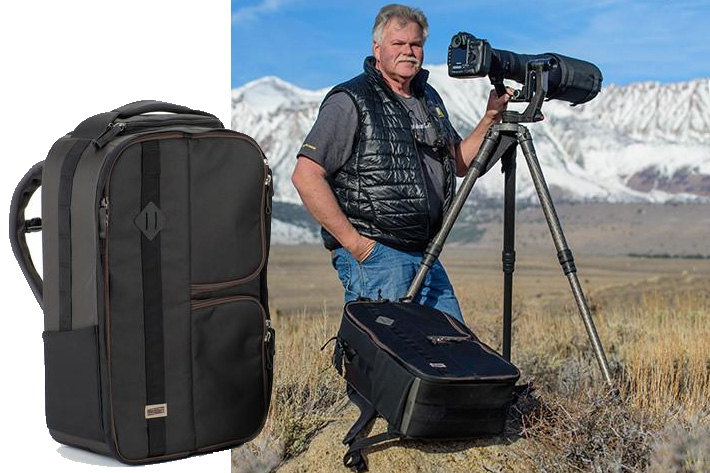
The original 1998 ‘Moose Ears’ backpack design with auto-close compartment flaps is back, on three versions designed for wildlife and safari photographers… and other photographers and videographers looking for a bag that carries a lot of gear but still fits in the overhead compartment of the smallest regional jets.
Back in the 90s Moose Peterson released three travel backpacks with a unique “Moose Ears” function that allowed access to gear, but provided a barrier to dust, other elements and prying eyes. The bags also looked like normal travel bags and not photo gear backpacks. Now, working in collaboration with Moose, the designers at MindShift Gear have upgraded the three backpacks while retaining their unique look, feel, and functionality.
The Moose Pack series is available in three sizes: MP-1, MP-3 and the smallest, the MP-7. A new MindShift Gear family of bags that has odd numbers because, as Moose Peterson says “I am odd”. The video used as a presentation for the bags is a good moment with some laughs and Moose’s usual willingness to share is experience with backpacks and photography. Take 10 minutes of your time to watch it. A microphone is the first thing Moose takes from inside the bag… so this is also a bag for the videographers out there. In fact, the three compartment layout makes for a good way to separate gear: lights, sound and camera/lenses.
The backpacks, depending on size, can carry up to three DSLR camera bodies with telephoto lenses attached—up to 600mm f/4. This strategy enables photographers to be ready to capture wildlife at any distance without changing lenses or exposing the sensor to the elements. The backpacks also feature the same innovative “Moose Ear” flaps that close automatically, protecting camera gear from dust and debris common in wildlife photography. And because nature photographers often travel to remote locations, the packs are designed to meet airline carry on requirements, and even fit in the overhead compartment of the smallest regional jets.
Even the small backpack, MP-7, fits a lot of gear. It holds 1 gripped body attached to 70–200mm f/2.8 and two ungripped bodies with primes attached, two flashes and accessories. Or it holds 1 gripped body and one ungripped body with 70–200mm f/2.8, 24–70mm f/2.8, 14–24mm f/2.8 (or 16–35mm f/2.8), a 2x teleconverter, two flashes and accessories. With a weight of 3.3 lbs. (1.5 kg), the MP-7 costs $199.99 and seems to be an ideal “one day” backpack solution many have searched for.
The MP-3 can carry 3 gripped DSLRs with lenses attached, 1–2 additional lenses and 1–2 flashes and accessories, or 3 gripped bodies and 1 ungripped body detached from lenses, 4–5 standard zoom lenses, 1–2 flashes, a 2x teleconverter and accessories. It’s weight is 4.6 lbs. (2.1 kg) and the price $279.99. In terms of maximum lens size, it holds a 600mm f/4 detached or 500mm f/4 lens attached to a gripped body.
The MP-1 sits at the top of the line, able to carry 3 gripped DSLRs with lenses attached, 3–5 additional lenses, 2x teleconverter, 1–2 flashes and accessories or 3 gripped bodies and 1 ungripped body detached from lenses, 7–8 standard zoom lenses, 1–2 flashes, a 2x teleconverter and accessories. It can hold a 800mm detached, as Moose Peterson shows in the video or a 600mm f/4 attached to a gripped body. MindShift Gear notes that 600mm lenses need to have the short foot; for example, the Nikon 600 must be fitted with the RRS LCF-13 or Wimberley AP-652. The MP-1 weighs 5.1 lbs. (2.3 kg) and costs $349.99.
Moose Peterson is a recognized Nikon USA Ambassador, Lexar Elite Photographer, recipient of the John Muir Conservation Award, and Research Associate with the Endangered Species Recovery Program. He also shares his knowledge through writing, being published in over 143 magazines worldwide, authoring 28 books including Photographic FUNdementals and Taking Flight and Captured, and lecturing across the country to thousands of photographers. As one of the original Nikon shooters to receive the D1 in 1999, Moose became the first wildlife photographer to shoot strictly digital.
“Moose Peterson backpacks are renowned for serving the needs of traveling photographers,” said Doug Murdoch, Think Tank Photo’s CEO and lead designer. “It has been a joy collaborating with him on bringing these classic designs back to the marketplace. While their design and materials have been enhanced, the designs of all three backpacks retain Moose’s original vision.”
